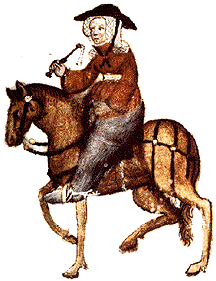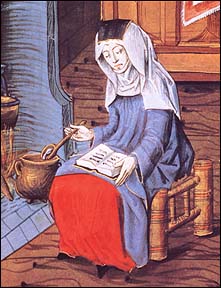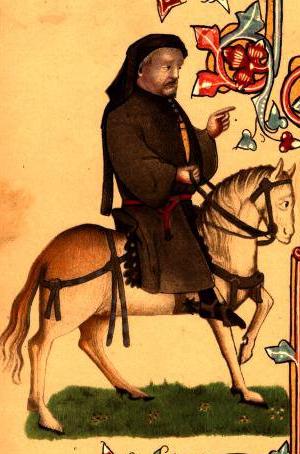
and The Wife of Bath’s Prologue
•add links for citation to Margery's
Book and the text of the Wife of Bath
•Flip Chaucer image so it points at the text?
The world of fourteenth century Europe was one of pervasive economic change. The medieval feudal system was quickly disintegrating as the burgeoning merchant class gained money, power, and influence. No longer could the landed gentry and nobility rely on feudal vassalage and indenture to provide for income and upkeep of their estates as a steady flow of people left agrarian, rural settings for more urban, mercantile centers. The pre-capitalistic system not only disrupted established economic modes but also altered long held social structures and ideologies. Out of this time of social and economic flux emerges Chaucer's Canterbury Tales. Himself a member of the emerging middle-class, Chaucer held a unique point of vantage at this time of transition between social classes. Hailing from humbler, lower-class beginnings, he had achieved a measure of success as a midlevel bureaucrat and was at times even a fixture at court. Chaucer’s perspective, poised on the cusp of the upper class yet struggling for financial solvency, gave him firsthand experience of the conflicts arising as the social classes reordered themselves, testing the boundaries of their power and influence under new economic conditions. His portrait of Dame Alice or Alison in The Wife of Bath’s Prologue is a way of characterizing these conflicts in class and economics as they manifest themselves in marriage and sex. Alison’s pursuit of wealth and her sexual antics are the metaphoric struggles of her class, and more markedly of her gender, in this time of social transition.
Like Alison, Margery Kempe struggles to find an expression of female authority in a patriarchal world. In her Book, the first English language autobiography, Kempe provides a real-life analogue to the Wife’s s fictional account. Both women express the emerging economic factors of their time by compromising their sexuality, reducing it and themselves to a reflection of their capitalist, male-dominated environment. Ultimately, as one might expect, as a deliberate rhetorical construct Alison’s account is more representative of the economic principles which she embodies. Kempe merely provides confirmation of the kind of dilemmas real women faced operating within the evolving economic landscape of this time. By operating within the bounds of this misogynistic patriarchy these women reduce their sexuality to commodity and thus reduce themselves by devaluing their humanity.
To understand how the economic tenor of this era makes itself felt in these women’s lives it is necessary to discuss briefly the evolution from agrarian to market economies and its effects on marriage and property rights. For this I will rely on a summary of Lee Patterson's argument in her essay "'Experience woot well it is noght so': Marriage and the Pursuit of Happiness in the Wife of Bath's Prologue and Tale." Patterson asserts that prior to the time in question, land ownership was the driving force of the economy. Lords employed peasants to cultivate their lands in exchange for a portion of the food production, shelter from the elements, and protection from enemies. During this time, marriage for the landed classes was a way to insure the continuance of property ownership through the production of heirs. This was important not only to the couple in question but also to society as a whole because of the dependence on the agrarian production that large tracts of land provided:
…it was at the church door that the property arrangements for the new couple would be ratified. Today we think it inappropriate and even sordid to allow economic considerations to contaminate the joining of two hearts and minds. But in the Middle Ages, as in fact virtually everywhere outside the contemporary Western world, marriage was considered a social as well as a personal matter. (Patterson 145)
However, the prevailing system of land-ownership and inheritance almost exclusively favored male control and dominance of the means of production. Women generally owned the property they brought to marriages but ceded control to their husbands who had absolute say in its dispensation until such time a male heir was produced to inherit control. Additionally, marriage allowed a degree of social climbing, as a husband could gain land and, presumably, position and prestige, through a new bride’s dowry.
With the rise of mercantilism, money began to become the prevalent commodity of exchange. Land was large, immovable, and not easily divisible (besides the fact it devalued itself when divided beyond a certain limit). Money was transportable and easy to exchange, as well as being easily divisible while still retaining its value. This economic transition marked a shift from a commodity that had an intrinsic value to one that had a symbolic worth. Land has an absolute value in its capacity for agrarian production, but money only has perceived value measured by for what it can be exchanged (Delany 85-86). The rise of money and mercantilism enabled a whole new class of people that would have been previously precluded from land ownership to obtain a measure of wealth. This new middle class faced the challenge of having the drive for what Marx calls "primitive accumulation" without the societal ideologies in place to rationalize or validate their experience. This shift in economic emphasis from land to money also marked a shift in marital strategies:
In such an economy, one can hold wealth in one’s own right, not as the representative of a family. Merchants might place less emphasis on the production of an heir than on the maximization of family labor: a wife and children serve less as conduits of family power than as a cheap and easily exploitable labor pool. (Finke 176)
The roles of women, then, in this male dominated society, are defined by their reproductive capacity. Women are only valued in their relationship to men and not for any independent worth. It is important to note that Chaucer intentionally defines Alison’s character in this way: as wife rather than woman (Patterson 138). Rather than companions or even people, men see wives as a means to achieve social status, wealth, and heirs. The conflict between pre-Middle Ages values and the social and economic realty of Chaucer’s Wife arises when women begin to think of themselves as men do: as commodity.
By her own admission, Chaucer’s Wife uses sex and marriage as
a means of exchange. There is little or no doubt that she enjoys sex
for carnal pleasure, but Alison also benefits from her sexual
appetites in other ways. Through her various marriages, she has
inherited enough money from her first three husbands to be
self-sufficient. Though Chaucer places her as a member of the middle
class, presumably an owner of a business in "clooth-making" rather
than a trades person herself, this is all he says on the subject.
Alison mentions no connection between her prosperity and profession,
but rather directly links her wealth with her other business venture,
marriage:
They had me yiven hir lond and hir tresoor,
Me neded not do lenger diligence
To winne hir love or doon hem reverence.
They loved me so well, by God above,
That I ne tolde no deyntee of hir love.
(204-208)
To Alison, love and sex are tools of conquest. Rather than being conquered as one might imagine in the patriarchal society of the time, Alison reverses the typical roles of men and women and pursues her husbands:
A wis womman wol bisye her evere in oon
To gete her love, ye, there as she hath noon.
But sith I hadde hem hoolly in mine hond,
And sith they hadde yiven me all hir lond,
What sholde I take kepe hem for to plese
But it were for my profit and mine ese?
(209-214)
These lines illustrate Alison’s mercenary pursuit of her husbands as well as her lack of emotional attachment in her role as wife. By careful selection of husbands who are both old and rich, Alison insures herself financial self-sufficiency. Beyond obtaining a suitable mate, Alison feels no sexual attraction or emotional attachment to these husbands. For the Wife of Bath, sex only has value for what it can be exchanged. In this way it is easy to see a direct metaphoric link between sex and money in the Wife’s Prologue. Like money, sex is exchanged for what Alison values: marriage, status, and wealth. While Alison’s marriages are financially rewarding, they do nothing to fulfill her emotionally.
Margery Kempe verifies the subconscious link between sex and money
as an example of the medieval woman’s internalization of early
capitalist principles. As an early entrepreneur, Kempe describes
failed business ventures. On pilgrimage, she constantly frets about
money and worries about being robbed. Kempe’s money
consciousness reflects the pervasiveness of capitalist thinking and
the drive for accumulation. Her narrative is rife with the language
of capitalism, most tellingly referring to the marriage "debt." It is
important to note the dehumanizing aspect of the marriage debt.
Society and religion institutionalized objectification of female
sexuality by treating sex as something that is owed to a spouse. Of
course this only serves to further devalue women as people by
treating them like a commodity:
And after this time she never had any desire to have sexual intercourse with her husband, for paying the debt of matrimony was so abominable to her...And so she said to her husband, "I may not deny you my body, but all the love and affection of my heart is withdrawn from all earthly creatures and set on God alone." But he would have his will with her, and she obeyed with much weeping and sorrowing because she could not live chastity. (46)
Kempe’s frustration and lack of fulfillment permeate her narrative. Unlike Alison, who embraces society’s valuation of her sexuality, Kempe struggles against the role that society grants women. She has apparently tried to be a "good" wife, bearing fourteen children to her husband. But her silence in her narrative about them indicates a lack of fulfillment in her role as wife and mother.
Until she is able to barter her sexuality for self-determination Kempe remains the property of her husband:
[She] went to her husband, saying to him, "Sir, if you please, you shall grant me my desire, and you shall have your desire. Grant me that you will not come into my bed, and grant you that I will pay your debts before I go to Jerusalem. And make by body free to God, so that you never make any claim to me requesting any conjugal debt after this day as long as you live." (60)
Kempe finally finds a measure of female authority through her faith. By bargaining for chastity, she finally wrests the power of self-determination from her husband. In this way Kempe differs from Alison. Kempe pays her husband’s debts, exchanging money for chastity. Alison exchanges sex for money. Both women achieve only the limited sort of independence possible in their misogynistic environments; Kempe finds fulfillment through her exchange and Alison does not.
While it is tempting to treat Alison as a person because of her
vividness or "realness" and make psychoanalytic remarks about her
motivation, one must keep in mind her status as a construct. Alison
is the product of Chaucer’s imagination, and as such the author
has the opportunity to use his character to comment on the social
conditions of his time. Are we to believe that Chaucer speaks through
the Wife of Bath, espousing her views on marriage and sex? Or is
Alison an extended metaphor for the middle class and its grasping
after money and influence? It’s unlikely that Chaucer, a man
within a predominantly patriarchal, misogynist society, would take a
feminist stance on marriage and sex that one might characterize as
"proto-modern" if not to condemn it. Rather, it seems obvious after
close reading that Alison’s sexual economics are a thinly veiled
reference to the problems within the world of Chaucer’s
pre-capitalistic society:
We wommen han, if that I shall not lye,
In this matere a queynte fantasye.
Wayte what thing we may not lightly have,
Therafter wol we crie all day and crave.
Forbede us thing, and that desiren we;
Preese on us faste, thanne wol we fle.
With daunger oute we all oure chaffare.
Greet prees at market maketh deere ware,
And to greet cheep is holde at litel pris.
This knoweth every womman that is wis.
(515-524)
The Wife of Bath here demonstrates a complete understanding of the capitalistic concept of supply and demand. Rather than relating this concept to goods and trade, Chaucer has Alison express his commentary on society’s woes in her own unique idiom: sex and marriage. The type of thinking that Alison displays here, reducing the woman from a person to a commodity, is prevalent even today six hundred years later. Additionally, Alison becomes the merchant of the commodity, putting herself on the market, selling her sexuality to the highest bidder.
Both Kempe and Alison use their sexuality to gain the upper hand in their relationships with their husbands but for very different reasons. Kempe struggles against the prevailing hegemony to find a measure of self-determination. She at least subconsciously refuses to accept the dehumanization of her person through her "sexual commodification." She eventually succeeds in liberating herself and her sexuality by using the tactics of the capitalism. Similarly, by expressing her sexuality in capitalistic terms, Alison attempts to usurp power from men by operating within the framework of a uniquely male power structure: the capitalistic patriarchy of medieval Europe. She uses this society’s misogyny against itself. Society tells women through its economic influence that they are little better than objects, valued only for their sexuality. Alison then uses the value that male society places on her sexuality to her own benefit. However, any such attempt at empowerment is doomed to failure because by working within the male power structure, on male terms, the woman forfeits her value as a person. This tactic backfires on Alison because by making concession to the male valuation of her person, she reinforces stereotypical notions about women by exemplifying misogynistic thought. By accepting the objectification of female sexuality as a commodity and using it as a tool, women set themselves up for failure.
Chaucer, Geoffrey. The Wife of Bath. Ed. Peter G. Beidler. Boston: Bedford, 1996.
Delany, Sheila. "Sexual Economics, Chaucer’s Wife of Bath, and The Book of Margery Kempe." Writing Woman: Women Writers and Women in Literature, Medieval to Modern. New York: Schocken, 1983. 76-92.
Finke, Laurie. " ‘All is for to selle’: Breeding Capital in the Wife of Bath’s Prologue and Tale." The Wife of Bath. Ed. Peter G. Beidler. Boston: Bedford, 1996. 171-188.
Kempe, Margery. The Book of Margery Kempe. Trans. B. A. Windeatt. New York: Penguin, 1985.
Patterson, Lee. " ‘Experience woot well it is noght so’: Marriage and the Pursuit of Happiness in the Wife of Bath’s Prologue and Tale." The Wife of Bath. Ed. Peter G. Beidler. Boston: Bedford, 1996. 133-154.
Images included are, in order of appearance: an illustration of the Wife of Bath from the Ellesmere manuscript, an illustration of Chaucer from the Ellesmere manuscript, and an illumination from MS Royal 15D1.
All images used taken from:
Jokinen, Anniina. "Geoffrey Chaucer." Luminarium: Anthology of Middle English Literature. June 12, 1998. http://www.luminarium.org/medlit/index.html Nov 20, 1998.
http://www.librarius.com - an online version of Chaucer's Canterbury Tales.
http://www.ub.rug.nl/camelot/teams/kemprint.htm - an online version of The Book of Margery Kempe.
http://www.luminarium.org/medlit/index.html - an excellent page providing biographical resource material for both Chaucer and Kempe.
http://english-server.hss.cmu.edu/marx - this page provides a compilation of the writings of both Marx and Engels.
http://www.haverford.edu/library/reference/mschaus/mfi/mfi.html - a medieval feminist index providing a search engine for feminist scholarship on the Middle Ages.
http://humanitas.ucsb.edu/shuttle/eng-med.html - The Voice of the Shuttle. This site is a great link page providing a jumping off point for a study of medieval history, literature, and literary theory.
This page was written and designed by Robert James for Dr. Daniel Mosser at Virginia Tech. I'd like to thank him for his assistance and encouragement. Any questions or comments can be directed to the author at rbrucej@hotmail.com.
Page Last Updated : 12/01/98 12:45 PM